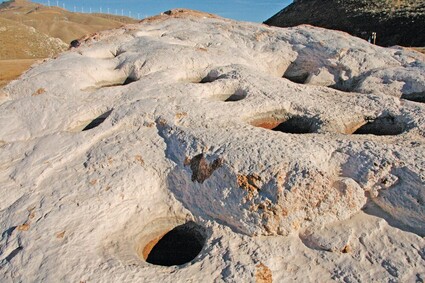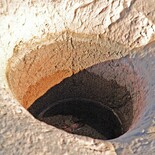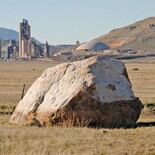The rock by the road
Land of Four Seasons
May 13, 2023

Jon Hammond.
The cement plant at Monolith is visible in the background as cattle graze at Proctor Lake, or lakebed.
As you leave the Tehachapi Valley headed east on Highway 58, you approach the Sand Canyon area. Visible to your left, on the north side of the freeway before you get to the Sand Canyon exit, a large boulder sits all by itself.
This oddly-placed stone did not tumble down from the hills above, and it wasn't left there by a glacier. Boulders can be carried hundreds of miles by glaciers, and when the glaciers finally melt, these stones, known as glacial erratics, are stranded far from the bedrock where they originated. These transported stones can be found in many parts of the world, and there are famous glacial erratics atop Olmstead Point in Yosemite National Park.
But the boulder at the east end of the Tehachapi Valley is not a glacial erratic. No, its current location is the result of both ancient and modern human hands.
This huge rock has about 16 pahaaz (pronounced pah-haah-z) or bedrock mortar holes in its surface that were made by Nuwä (Kawaiisu or Southern Paiute) Indian women grinding acorns and other seeds for their families. The fact that it was a longtime milling site is indicated by the size and depth of the mortar holes.
Over the many decades, likely centuries that the Nuwä women used this boulder, it was mostly submerged in the surrounding soil, with only the upper third exposed as a largely flat, level stone outcropping.
Because bedrock mortar holes are literally carved into stone, it is difficult to know how old they are – once made, they don't go away, even after thousands of years. So a pahaaz in the Tehachapi Mountains might be 200 years old, or it could be 2,000 years old. Or older. Perhaps some date in between.

There are currently no oak trees anywhere near where the pahaaz boulder is located, so there is no evident source for acorns to grind. There probably were oak trees in closer proximity in earlier centuries. Plus the Indigenous women used milling sites like this one for grinding other seeds besides acorns. The Nuwä people also harvested salt from the lakebed during warmer months when the shoreline retreated.
In any case, outsiders began to arrive in the Tehachapi Mountains in large numbers starting in the 1850s, and the big flat pahaaz rock at the east end of the valley stopped being used. The boulder sat there as it always had, but the Indian women no longer brought their harvest to be processed.
Then about 100 years after the outsiders arrived, construction began on a big toov (pronounced TOH-vuh), or road to carry more cars and trucks through the area. The pahaaz tibi, or mortar rock, was in the way and had to go.
Somewhat uncharacteristically, the men building the road decided that rather than blast the boulder into pieces with explosives, they would move it out of the path of the coming state highway.
And somehow they did move the boulder, though it must be incredibly heavy, and looks like it may weigh 50 tons. They dug it out of the Tehachapi soil and moved it over to adjacent land out of the path of the road.
At the time there was apparently discussion about moving the rock to a museum site someday. Exactly how a historical society and a handful volunteers could possibly manage to move a boulder of that size, or even where they would put it if they could, was evidently not part of the discussion.
About 55 or 60 years have passed since Highway 58 was completed through Tehachapi and the pahaaz rock was relocated. It now sits on the eastern tip of Proctor Lake, or lakebed, which is basically a low-lying meadow these days. Cattle sometimes rest in the shade on the north side of the big rock on hot days.
And thousands of cars a day drive right past, unaware that this sentry rock has a history of its own. . . .
Keep enjoying the beauty of life in the Tehachapi Mountains.

Jon Hammond.
Pahaaz or bedrock mortar holes were made by generations of Kawaiisu women during the centuries when this boulder was imbedded in the soil, where the traffic of Highway 58 now travels.
Jon Hammond is a fourth generation Kern County resident who has photographed and written about the Tehachapi Mountains for 38 years. He lives on a farm his family started in 1921, and is a speaker of Nuwä, the Tehachapi Indian language. He can be reached at tehachapimtnlover@gmail.com.






